

Jannicke Wiese-Hansen and Tor Ola Svennevig invite you into their studio to talk about their craft, promoting Norwegian art and culture, as well as taking their Nordic culture back from the abuse of the extremist right. The two tattoo artists have also written short artist presentations about their personal journeys within the tattoo field.
In a traditional Hanseatic wooden building from 1705 in Bryggen in Bergen, Norway, you find Nidhogg Tattoo Studio, where tattoo artists Jannicke Wiese-Hansen and Tor Ola Svennevig share a workplace. Located in a UNESCO World Heritage Site, the space hosts four artists in total, and couldn’t be a better backdrop for the work of Jannicke Wiese-Hansen and Tor Ola Svennevig, who specialise in Nordic cultural tattoos, both medieval and Viking-inspired. In their artist presentations, Wiese-Hansen and Svennevig give us a glimpse into their rich careers, their love for their Nordic heritage, and their individual journeys to becoming two of Norway’s most canonical and defining tattoo artists.
Jannicke Wiese-Hansen
My creative journey started 30 years ago designing logos and album covers for the Norwegian black metal scene, including work for bands like Enslaved, Immortal, Burzum, Satyricon, Gaahls Wyrd, and many more.
In fact, I give credit to black metal for my tattoo career. In the early 1990s I was working at a rock club, the legendary Garage in Bergen. I worked both behind the bar, and later as a bouncer. One evening Tomas Brudvik, the only tattooer in town, approached me and asked if I had made the logo for the band Immortal. I confirmed, and he offered me to draw Flash for his newly opened studio, where he could pay me in tattoos.1
The best deal ever, so of course I accepted it, and two years later I became his apprentice. To this day I still do work for the black metal scene, even though, with so many other projects and my full-time job as a tattoo artist, the day does not have enough hours for everything I would like to do.
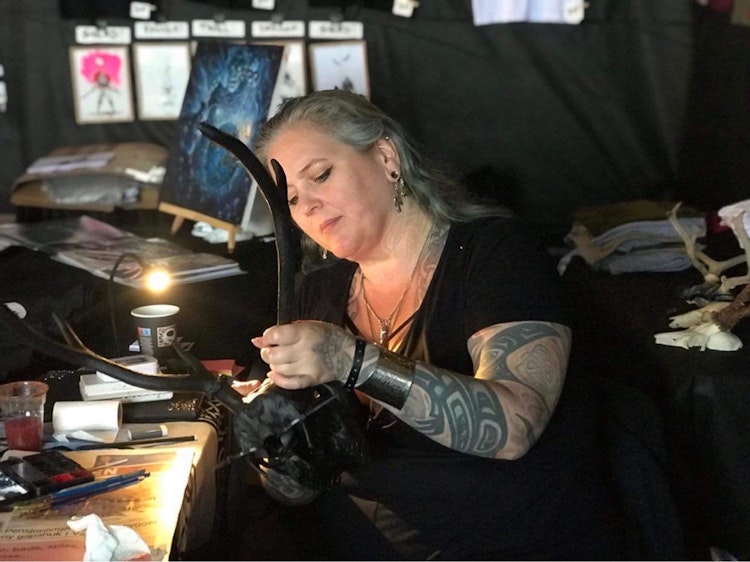
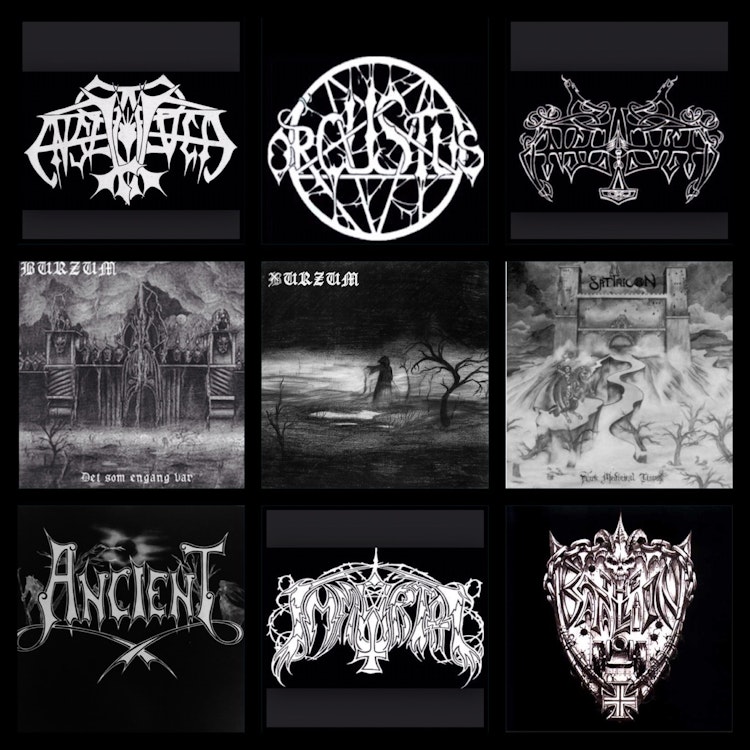
It is now 28 years since I became an apprentice at Let’s Buzz Tattoo Studio. I continued to work there for 20 years before opening my own studio, Nidhogg, together with my colleague Annlaug Maria Tolo. In the beginning I tattooed every style, from colour to black and grey, from old school to realism. A decade into my career, I started specialising in woodcarving tattoos. These tattoos are strongly inspired by Norse mythology and stave church ornaments, an artform I fell deeply in love with.
Finding my woodcarving style began with a coincidence. It started when a client came into the studio and asked me for a wood-carved raven on his arm. My father has always carved in wood, and he collects Haida woodcarvings. I love the chopped rough look of the carvings, and I loved recreating it on skin. After that first client, I had another come in a month after, asking for a tattoo on his shoulder, showing parts of a clock that his grandfather had carved. A few months later, another client wanted both sleeves tattooed with the carvings of the door portal of the Hylestad Stave Church. I loved every second of these projects. The costumer had some good photos taken and posted them on Pinterest, and as a result, an increasing interest for woodcarving tattoos grew, and I did more and more of them. Sandor Jordan, a German tattoo artist that came to work at the studio, had visited many conventions around the world and had never seen this style before. He told me to just drop everything else and just focus on the woodcarving style. Oh, am I glad I listened to him!
Every time I find a new book with detailed photos of these wonderful woodcarvings, I’m like a kid in a candy store.
My woodcarving tattoos have resulted in clients travelling from all corners of the world to get my work on their skin. It is amazing to share Norwegian art and culture like this, and it is as enjoyable to tattoo now as it was when I started. Still, I strive to always improve my techniques and expression, making the textures better and more realistic. The road of trying to develop my art is never ending, and I try to visit the stave churches as often I can to study the amazing woodwork. It is truly breathtaking how the ornaments are carved in such a large scale, done so many hundreds of years ago. When I happen to come by an old house in the Norwegian countryside with amazing worn wooden structures, I take photos to use as a reference. I try to bring that same texture of wood into my tattoos; withered wood, insect holes, and any detail that I can add. My clients might ask for the Urnes style or the Oseberg style, naming different ornaments styles from stave churches, boats, or even old furniture.2 I know most of these styles by heart now, so I keep them in mind; maybe I hang up a reference photo, but mainly I will draw the tattoo freehand with markers directly on the skin. This way I avoid making the carvings look too static. There is a huge difference between a straight doorway made of wood, and a muscular arm that bends and curves. The tattoo needs to reflect the body’s forms, lines, and mobility. Sometimes I get to combine different styles and it is such a thrill to fuse them together. I continuously try to better my skills by observing the carvings in books and in real life. Every time I find a new book with detailed photos of these wonderful woodcarvings, I’m like a kid in a candy store.
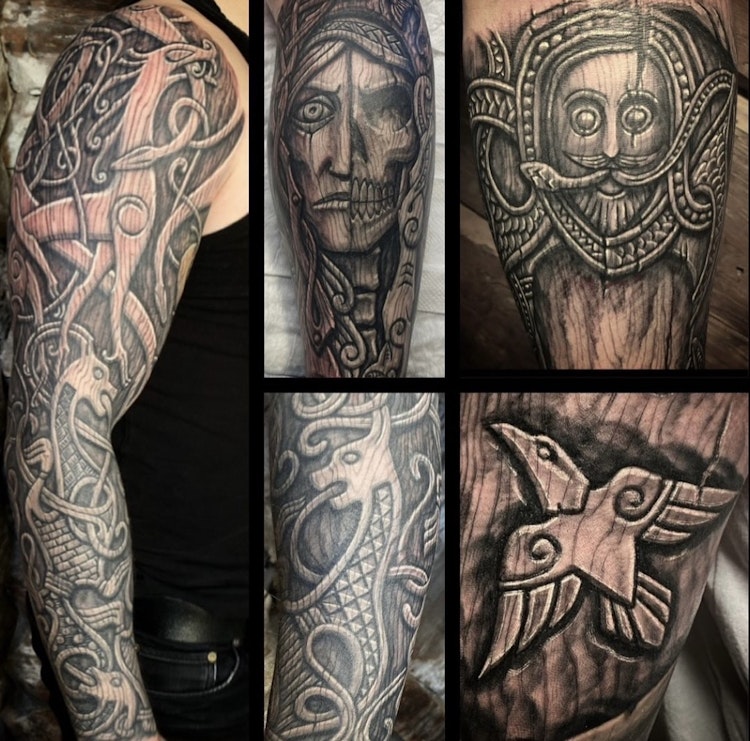
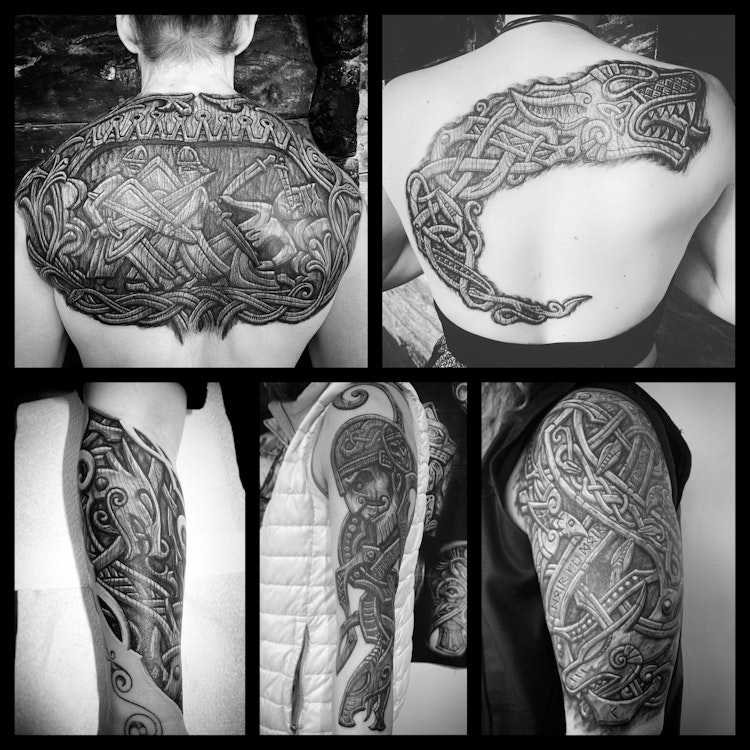
In addition to a full appointment book at the studio, my style of tattooing has opened the door to other projects. I designed a series of around 25 official memorial coins, both in gold and silver, for Samlerhuset and the Isle of Man in the UK. This, in relation to the celebration of their 400 years of Viking rule.2 Every illustration I made had to be approved at the Thing at the Isle of Man, and also by Buckingham Palace, since the official portrait of Her Majesty the Queen was adorning the other side of the coin. This is one of the biggest honours of my career.
Together with Tor Ola Svennevig, I was invited by the Cultural Historical Museum in Oslo to tattoo in the Viking Exhibition during Oslo Culture Night in 2015. Tor showed his historical hand poking tattoo technique, and I showed the technique of modern tattooing. All this, while a man in a suit and tie danced ballet with an excavator in the parking lot. It was a culture night indeed!
Yet another amazing thing that I got to be a part of was when I was asked to be a member of the team organising the black metal exhibition Dårlig Stemning at the National Library of Norway in 2023. Here I worked mainly as an adviser for the exhibition’s design and expression, and I designed the logos.
To me it is important to take these symbols back and reject them as a symbol of hate and a misplaced ‘Aryan pride’.
It has been over 30 years since I drew my first black metal logos and album covers, almost 30 years since I started my tattoo fairytale. Especially in the tattoo scene, things have changed. In the 1990s, clients wanted small tattoos that were easy to hide, unless you were inspired by the character Romper Stomper from the movie From Dusk Till Dawn (1996); he had his whole arm covered with tribal tattoos. In the 2000s, TV shows like Miami Ink (2005-2008) and LA Ink (2007-2011) changed the rules. The clients now wanted whole back pieces, sleeve tattoos, and other huge pieces. And they dared to use more of their own ideas, or ask for our creative input. This was a turn towards the less mainstream, and it was great for us tattoo artists, since it allowed us to play around with huge tattoos. Luckily for me, many clients wanted my style of woodcarvings instead of the tribal tattoos.
In the last decade, the interest in Viking and Norse culture has exploded. TV shows like Vikings (2013-2020) and a big number of computer games have contributed to this. The interest is as big in the USA as in Australia, Germany, or Scandinavia. Sadly, this last century, much of the typical Norwegian cultural identity, for example runes, has been misused by the far right and has been wrongly identified as Nazi or right-wing extremist. To me it is important to take these symbols back and reject them as a symbol of hate and a misplaced ‘Aryan pride’. I do think our efforts are working; now I have far fewer right-wing extremists contacting me to become clients. Either it is working, or my reputation of not doing far-right tattoos has reached them. Anyway, the job is not done, and we are many ‘Viking’ tattoo artists, in Norway and abroad, working on taking the symbols, culture, and expression back to the good side.
I am always looking forward to seeing what new projects are hiding behind the next corner, and I love the thrill of never knowing what it will be. For my own part, I have several plans for the future, including books, bed linens, and even candy, but we’ll see when and if that happens. Tor and I often talk about how lucky and thankful we are to have jobs that we love and that bring us all around the world, and that we get to meet so many good people through this line of work. Lucky indeed!
Tor Ola Svennevig
I was born in the former municipality of Hedmark, Norway in 1978, a landscape with a rich history, forests, and coastal heritage, which was formed by sailors and craftsmen. This has shaped me and given me the motivation to journey beyond the typical assumptions that are often attached to the craft of tattooing. As a tattooer I define myself as a craftsman, and I have always seen tattoos as an artform.
As a child I often pondered how drawings were made permanent in the old sailors' skin. When I figured out what tattoos were, at the age of nine, I tattooed myself and a childhood friend in ‘the old sailor style’, using two sewing needles that were bound together and some ink. My parents never saw the tattoos, but my friend's parents did, so it took seven years before I tried to tattoo again. This next time, it was by hand as well, and this time I did not stop, but rather this soon led me to buy my first tattoo machines and equipment through postal order from the US. My father, who held a special love for the sail ship era and sailor culture, approved of me tattooing from my childhood home.
My love for tattooing has always been more connected to the past, than the present. I have had an increasing interest in Nordic heritage and sailors’ tattoos in my work; this interest was, among other things, related to a strong need to know more about what it was that first inspired me to become a tattooist. This led me to start documenting the tattoos that the old sailors of Norway got when they were out at sea. My work became the book Norske sjømannstatoveringer = Norwegian Sailors Tattoos (2013) which in turn resulted in my next book Johan Fredrik Knudsen - electrical tattoo artist (2022).1
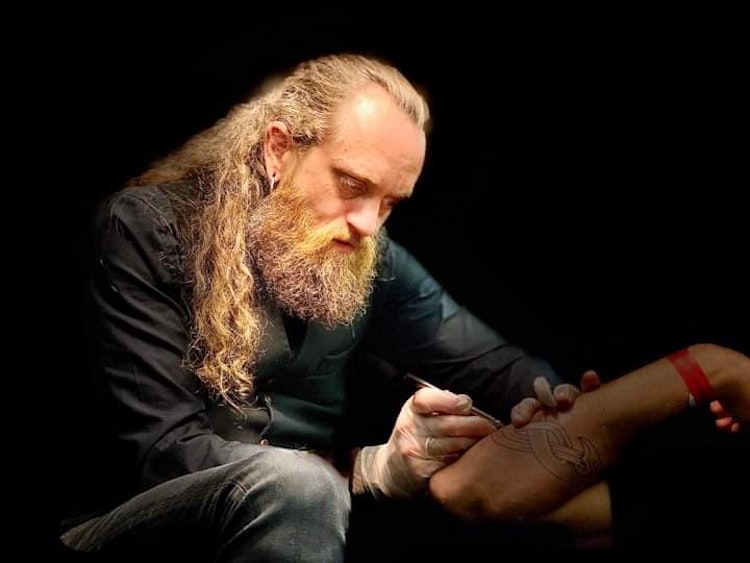
When it comes to diving deeper into the matter, I stay humble to the fact that this is one of the world’s oldest trades and that there always remains more to learn.
In the beginning, my inspiration came from the contemporary tattoo and music scene. Tattoo artists like Henk Schiffmacher, Erik Reime, and Henning Jørgensen set the scene for a new tattoo era, while Tribal, Celtic, and Nordic tattoo patterns became my generation's classic designs, like the ship, rose, and eagles were for the sailors.
In the late 1990s, I started my formal education as a gold and silversmith at the Plus school in Fredrikstad. During that time I continued to tattoo more frequently, and soon after graduating I started to plan my first tattoo studio and jewellery workshop. My education inspired me and shaped me as a craftsman. For the first eight years when I was building my tattoo studio into a solid business, the jewellery and metalwork made it possible for me to survive without having to compromise on my tattoos. Since then, they have become a hobby and a side job.
Tattoos and photos by Tor Ola Svennevig.
From early on in my career I have been working in blackwork style, where the tattoo is carried out solely by using undiluted black ink. I also mostly use defined dotwork as a way of shading and giving structure to the images instead of blending different tones. Through the years I have focussed more and more on my heritage, seeking inspiration from the old Norse ornaments and a tattoo tradition that once was. I do not seek to re-enact the past, but rather I create my own style of Norse ornaments within the requests and framework of my customers.
Through the years I worked mostly with machines, and here I have had the chance to develop my hand tattooing skills, in relation to a growing customer demand. In 2016 I celebrated the 15-year anniversary of my studio Ihuda Tattoo and decided that, from that day on, I was to put my tattoo machines down and only focus on tattooing by hand. There were several reasons for this choice. First and foremost, it was to challenge myself crafts-wise, and to gain a deeper understanding of the complex simplicity created by a few needles and pigment.
The same year, I was invited to work at the Cultural History museum in Oslo together with Jannicke Wiese-Hansen, where we showcased two different ways of making Norse-inspired tattoos based on historical objects from the museum’s collection. At that time Jannicke had just started Nidhogg Tattoo in Bergen together with Annlaug Maria Tolo, and new bonds started to form. I had then just met my soon-to-be wife who lived in Bergen, and it became natural to do regular guest work at Nidhogg Tattoo. The following year, I closed my studio in Fredrikstad and moved to Bergen to become a full-time part of Nidhogg Tattoo, where I have remained since.
I feel privileged to be given the trust that my customers grant me, and to be a part of Nidhogg Tattoo together with my talented colleagues. When it comes to diving deeper into the matter, I stay humble to the fact that this is one of the world’s oldest trades and that there always remains more to learn. I am still researching tattoo history, and I look forward to seeing more secrets of the past come to light.




